| |
 Opinion Opinion
Third in a five-part feature on the future of fundraising, from
Ken Burnett, author of Relationship Fundraising, (1992).
The first of this series appeared in November 2014 and the final part was published in mid-May 2015.
Intro
The future of fundraising.
Part 1
Why fundraising has to change.
Part 2
A fundraising Utopia.
Part 3
Some keys to
fresh fundraising success. Three mega-opportunities
for fundraisers.
Part 4
Marketing was a mistake.
Part 5
Fundraising and the rule of law.
Home page.
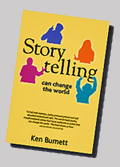
Ken’s storytelling book is reviewed here and here and you can buy it here.
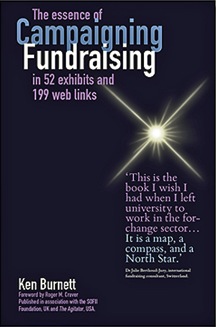
You can order
The essence of Campaigning Fundraising here. Please follow this link for reviews too.
|
Fundraising and fundraisers have taken a bit of a battering from various quarters recently, so perhaps we self-appointed pundits should take a break. Soon, I promise. But for this the third in this five-part feature I’m going to be positive as I seek to define some mislaid keys of fundraising then show you how, with our freshly-refocused profession behind them and with all the skill, passion and purpose we possess, we just might – if we make the right changes to how we do what we do – take full advantage of mega-opportunities like these.
Could fundraising and fundraisers really be on the verge of a golden age?
Here are three glittering reasons why we could be. And one big fat hairy barrier that could spoil everything.

We could be inspiring donors for life.
Any serious professional fundraiser would need to have his or head very deeply in the sand not to realise there’s a new emphasis now on donor retention matched with an urgency to get it right (see here). Adrian Sargeant and colleagues have repeatedly shown us the massive impact on our bottom line that even a small increase in retention rates would bring. All fundraisers need to keep their donors closer for longer, to keep them happy, inspired, feeling great, loving their giving and the big difference they make. And happy to continue their giving, as long as we need them.
So what’s stopping us?

More active older people looking for meaning
Demographic change in the world’s most affluent countries will profoundly affect our society in the next 20 years. As our populations age, in the UK, USA and other markets there will be a massive increase in the 65+ age segment, fundraising’s prime donors. In the UK growth will be more than 60 per cent. But donors living longer isn’t all good news for fundraisers. In an increasingly uncertain world extra demands and pressures will come with these extra years. Yet with carefully structured, inspirational guidance from us, donors of the future could see real joy and meaning in their giving that will enrich and fulfil their extra years, as they come to realise that engaging with our causes will add genuine meaning and fulfilment to their now much longer lives.
Are we ready for this?

A new relationship with business partners
CSE stands for corporate social engagement. CSR, or corporate social responsibility, is yesterday’s way of looking at corporate fundraising. CSE shows companies and charities can work together to make things better for both businesses and for their customers too. It's not about responsibility, it’s about engagement. It’s not about them giving and us taking, it’s about constructing inspirational win/win partnerships of mutual benefit that make a difference in the world.
Could you answer the businessman’s questions opposite? Clue: he won’t feel reassured by you just asking him to give you money, nor by repeatedly making him feel bad about what he and his business can’t do for you. It’s not about what you need or want, it’s much more about what you give. It’s about what you can bring to the boardroom table, in a two-way partnership, to show the remarkable difference both parties can make when cause and company combine to motivate staff, management and customers as, together, they deliver a powerful amount of good.
Thankfully in the UK at least charities seem to be waking up to the new mood in business and making their plans to get in on it. Not so, generally, with individual donors. Yet the potential is massive and available for all.
So what’s the big fat hairy barrier?
What prevents us from making the most of all these opportunities, tragically, is the nature and quality of the experience that we've traditionally offered our donors and that, in our current paradigm, we seem unable to change. It’s this that explains why I now advocate storytelling over selling and why the next part in this series is called, Marketing was a mistake. Controversial, I know. But I can’t defend the status quo any longer.
Change is coming
What do we have to change, to fully achieve this fantastic potential? I’ll have more to say about this, in the next two posts. And please, feel free to email me your thoughts here.
© Ken Burnett 2015
Home page | Current blogs | Article archive |
|
 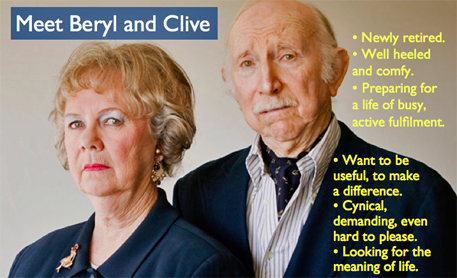
It won’t be pushy sales scripts or repeated asking that will win over long-term support from the likes of Beryl and Clive, above. Nor will that approach cut much ice with businessmen like the famous chilly prospect, below. But we might just be sitting on something that both of these audiences really want
– if we can only find a better way of presenting it to them.
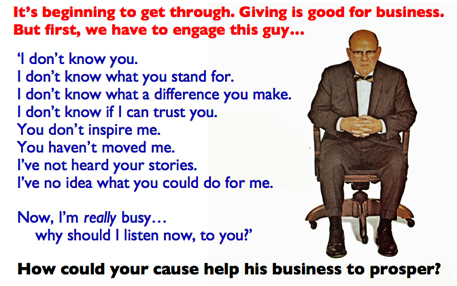
As well as the new wind beginning to blow through corporate boardrooms, demographic change seems set to work in our favour too. I served as a commissioner with the group mentioned below. Our conclusion? The voluntary sector is nowhere near ready or equipped for the change that's coming.
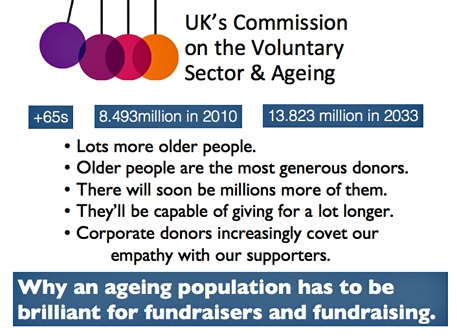
This analysis of the future of fundraising is in five parts:
Part 1. Why fundraising has to change
Part 2. A fundraising Utopia.
Part 3. Three keys to fresh fundraising success. Some mega-opportunities for fundraisers.
Part 4. Marketing was a mistake.
Part 5.
Fundraising and the rule of law.
See also the forewords to two important fundraising books published in 2015, here. Retention Fundraising by Roger M Craver and How to love your donors (to death) by Stephen Pidgeon.
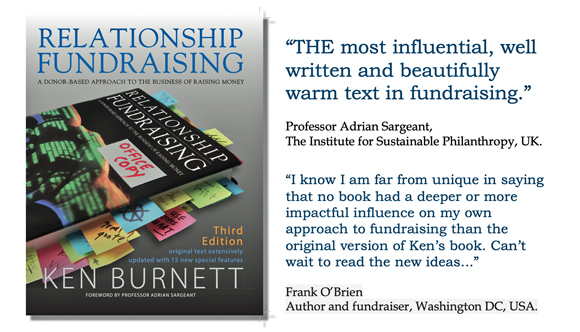
|










